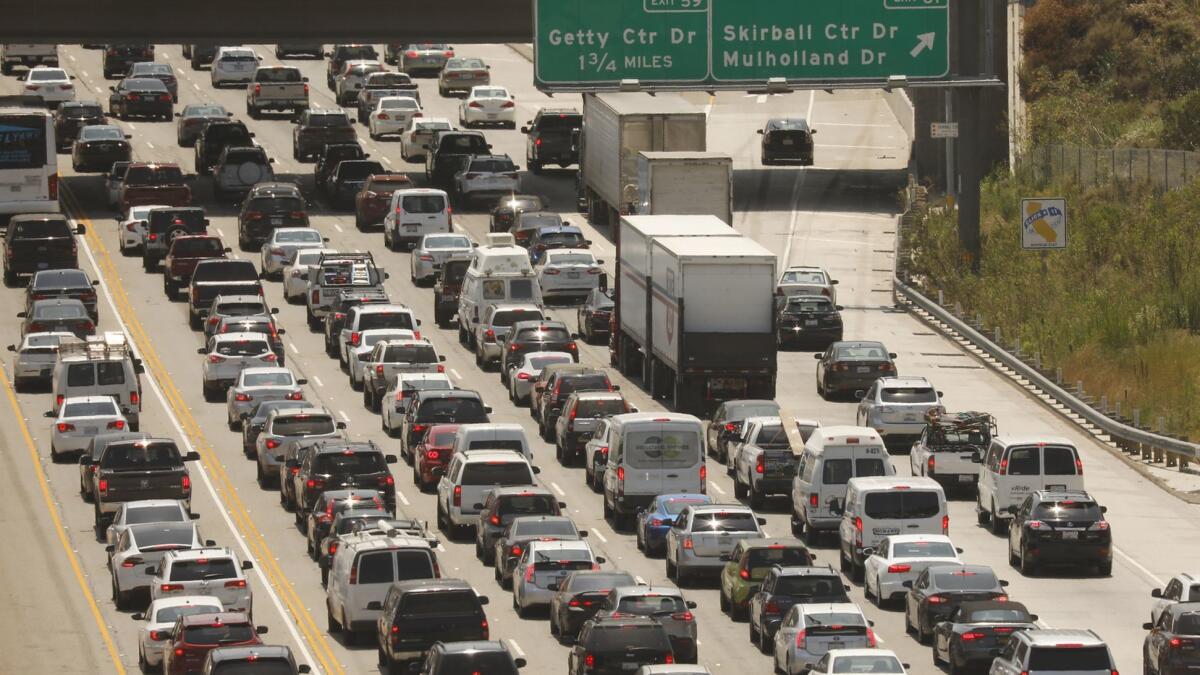Column: California responds to Trump on auto emissions by saying: Game on!

- Share via
A mere five days after the Trump administration proposed loosening auto exhaust standards and revoking California’s authority to set its own rules, California air pollution regulators published their response on Tuesday. Boiled down to the gist, it says: No dice.
The state Air Resources Board isn’t only challenging the administration’s right to change the rules as it proposes. The board also says it will hold auto manufacturers to the existing standards, even if they’re loosened by the federal Environmental Protection Agency and National Highway Traffic Safety Administration as the Trump administration intends.
That won’t be pleasant for automakers, which unwisely pressured Trump to relax the standards. In congressional testimony in May, a leading industry lobbyist pleaded with Trump to “find a solution that continues to: (1) increase fuel efficiency standards year-over-year and (2) incorporate California to ensure that ‘One National Program’ is maintained.”
California must act to ... maintain the benefits of its emission standards.
— California Air Resources Board
The lobbyist, Mitch Bainwol of the Alliance of Automobile Manufacturers, was asking for a rollback of emissions standards, but one not so draconian that California would balk. Otherwise, he said, the result would be a “regulatory nightmare” in which automakers would be forced to deal with “a bifurcated regulatory system — one for California and the additional 12 states that follow its program and one for the other 37 states.” Trump didn’t listen, and the nightmare looms.
As we’ve reported before, the existing standard calls for average fuel efficiency for the U.S. vehicular fleet of 55 miles per gallon by 2025. The government proposed on Aug. 2 to ratchet that back to 37 miles per gallon. The government also proposed to revoke the waiver, written into the Clean Air Act in the 1970s, allowing California to set its own fuel efficiency standard. The waiver was most recently renewed in 2013 by the Obama administration. Because 12 other states are in sync with California, the state’s rules effectively cover about 40% of all auto and light truck sales in the country.
This column is one of a series on the conflicts between California and the Trump administration. Feel free to send comments or ideas to [email protected].
The state board’s response came in the form of a statement prepared in advance of a public hearing scheduled for Sept. 27 in Sacramento. The document questions whether the administration even has the legal authority to change the rules without undertaking a fact-finding process at least as rigorous as those that preceded earlier rulemaking — and those took years of study, reduced to hundreds of pages of documentation.
The most recent finding, the state board observed, was released on Jan. 13, 2017, or a week before Trump’s inauguration. At that time, the EPA concluded that there were no reasons to reduce the emissions standards, finding that “automakers are well positioned to meet the standards at lower costs than previously estimated.”
Trump’s EPA announced on March 22, 2017, that it would abandon the January finding. On April 13, 2018, the EPA announced that the existing standards “may be too stringent” and appended a finding of all of 11 pages to back up its conclusion. “EPA did this without properly explaining why it was departing from the extensive evidence” in the record, the state says.
Statements from the administration, the state says, show it believes that regulations that “provide significant greenhouse gas emission reductions, public health benefits, … and fuel savings for consumers … are nonetheless not worth the perceived burden to manufacturers and other industry.” As a result, “California must act to … maintain the benefits of its emission standards.”
As for the threat to withdraw the waiver, the state called that “legally unfounded, unsupported by the evidence, and contrary to the core structure of the federal Clean Air Act and decades of precedent.”
From the automakers’ standpoint, the most serious threat in the state’s proposal is to withdraw the “deemed to comply” rule by which manufacturers can meet California’s auto standards by complying with the EPA’s. That rule is almost meaningless when the state and federal standards are essentially identical, as they are at the moment.
But under the state’s plans, if the federal government rolls back its standards, manufacturers would be “deemed to comply” only if they met the old EPA rules.
The auto industry has been whining for years about the impossibility of meeting the 55-mpg standard by 2025. California and the pre-Trump EPA believed its complaints should be taken with a mound of salt. In his testimony, Bainwol observed that while consumers expressed a desire for electric and hybrid electric cars in the abstract, only about 1% of sales of new vehicles fell into those categories in 2017.
Why so few? Bainwol blamed “cost, range anxiety, lack of necessary EV charging infrastructure or a lack of education surrounding the many benefits of EVs.” This list suggests some solutions. Manufacturers can bring down the costs, as they probably are doing already. They can increase the range of the cars to reduce consumers’ anxiety about running out of juice on the road. They can invest in charging infrastructure. And they can devote more advertising dollars to “educating” consumers about the virtues of electric vehicles.
These initiatives will be expensive, but they won’t be done if the industry thinks it’s cheaper to lobby against more stringent efficiency standards than to invest in a solution. Bainwol also pushed for expansion of the federal government’s EV tax incentive, which comes to as much as $7,500 per vehicle, but gets phased out for any manufacturer after it sells 200,000 EVs. (Tesla is on the verge of hitting that wall already.) Interestingly, expanding the tax incentive didn’t seem to make it into the Trump administration’s fuel-efficiency proposal. Speak up, Mr. Bainwol!
Twitter: @hiltzikm







